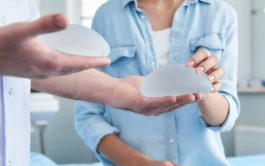
Choosing the Right Breast Reconstruction Option For You
Breast reconstruction can be an important part of the recovery process for women who have undergone a mastectomy. Breast reconstruction surgery aims to restore the look and feel of a woman’s breasts after a mastectomy, and there are several options available for reconstruction depending on your specific preferences, health status, lifestyle factors, cancer treatment plan, and anatomy.
It can be challenging to arrive at a final decision when considering the different reconstruction options available. Explore the benefits and potential drawbacks of each procedure and consult with your Ohio plastic surgeon to discuss which will help you achieve your desired results.
Reconstruction With Implanted Materials
Breast reconstruction can be accomplished using a permanent breast implant made of either silicone or saline positioned under the skin and pectoralis muscle. Implant-based reconstruction can be done in multiple stages or as a single step.
Staged Breast Reconstruction
A traditional mastectomy removes the breast tissue and skin, leaving a relatively flat surface on the chest. In such cases, the staged approach with initial tissue expansion is necessary to expand the skin and create a permanent implant space. Staged breast reconstruction involves placing a tissue expander under the skin and pectoralis muscle after a mastectomy. A breast tissue expander is a temporary implant device that is slowly filled with saline over time to stretch the skin and muscles on your chest. This is done in an outpatient setting and continued until the expander is filled to the desired size. After several weeks or months of gradual tissue expansion, the expander is removed and replaced with a permanent breast implant made of either silicone or saline.
Other mastectomy techniques, such as the skin-sparing and nipple-sparing procedures, remove mainly the breast tissue while leaving much of the skin of the breast and chest intact. If an adequate amount of skin is spared, it is sometimes possible to avoid the initial expander stage and place the permanent implant at the time of mastectomy. This approach is known as a direct-to-implant breast reconstruction. The ideal candidate for such an approach is typically a smaller cup-size patient with excellent skin quality. The direct-to-implant reconstruction is only possible immediately following the mastectomy.
Reconstruction with Natural Tissues
Breast reconstruction surgery using your own body tissue can create a more natural look compared to implants. This involves sourcing a flap of tissue from another part of your body (typically the abdomen, back, thighs, or buttocks) to replace the removed breast tissue after a mastectomy. There are two main types of flaps we can use.
- A pedicled flap means the flap is moved while still attached to its original blood vessels. For example, in a latissimus dorsi flap, tissue from your back is tunneled up to the breast while still connected to blood flow from your back. A Pedicled-TRAM flap follows a similar procedure but utilizes tissue from your abdomen.
- Alternatively, free flap reconstruction is when tissue is completely detached from its original site, typically from the back or abdomen. Blood vessels are then reconnected at the breast using microsurgery. Free flaps involve more extensive surgery but allow us to use tissue with a more robust blood supply for the best reconstruction results. The following are various reconstruction options to consider:
Pedicled TRAM (Transverse Rectus Abdominus Myocutaneous) Flap
During a pedicled TRAM flap procedure, tissue, muscle, and skin are taken from your abdominal area while still attached to the original blood supply. The TRAM flap contains fat and skin from your lower belly, along with a portion of the underlying rectus abdominus muscle, one of the four major muscles in your abdomen. Because it contains muscle, a TRAM flap has a robust blood supply. This helps the transferred tissue survive well. One tradeoff is that removing part of the rectus muscle can lead to weakness in your abdominal wall afterward. However, exercises can help strengthen the remaining muscle.
DIEP Flap (Deep Inferior Epigastric Artery Perforator)
This is an ideal option for breast reconstruction surgery because it can produce natural results using your own tissue. Skin, muscle, and blood vessels are taken from the abdomen and shaped into a breast mound that best fits the shape and size you desire. Most patients are suitable candidates for reconstruction using a DIEP flap. Previous abdominal surgeries, such as a hysterectomy and C-section, are typically not an issue. However, some operations, including tummy tuck and hernia repair with mesh, can be limiting. For patients who do not have an adequate amount of tissue on the lower abdomen, other perforator-based flaps (such as the GAP, TUG, or PAP flap) or breast implants are alternative options.
Free SIEA Flap (Superficial Inferior Epigastric Artery)
This option is comparable to DIEP flap reconstruction, but does not remove the muscle under the lower abdominal tissue, altering the blood supply to the breast tissue upon implantation. SIEA flap procedures have a short recovery time because the muscle beneath the skin remains untouched; however, this is not always a viable option for patients. The health and capacity of the superficial blood vessel will determine if you are a good candidate for this procedure.
Gluteal Artery Perforator (GAP) Flaps
This procedure utilizes tissue from the buttock region. The SGAP, or superior gluteal artery perforator, takes a flap from the upper 1/3 of the buttock. Alternately, the IGAP, or inferior gluteal artery perforator, the flap is harvested from the lower aspect of the buttock, just above the fold between the buttock and thigh. The GAP flaps are particularly useful for patients whose lower abdomen is not an ideal donor site either due to an inadequate amount of tissue or previous abdominal surgeries, such as tummy tuck or hernia repair with mesh, which would have damaged perforating vessels needed for flap survival. Fat is distributed differently for most people, so often, if a patient’s lower abdomen is too thin for a DIEP or stacked flap, the buttock region may still have adequate tissue to serve as the donor site.
Free TUG or PAP Flaps (thigh)
The transverse upper gracilis flap (TUG flap) uses tissue from the upper, inner part of the thigh. As mentioned above, some patients do not have much tissue in the lower part of the abdomen and are not good candidates for DIEP flaps. Often, these patients may have a reasonable amount of tissue in the upper part of the thigh. The TUG flap surgery uses skin, fat, and a small portion of muscle from this area. While this donor site is well concealed in clothing, it is difficult to get a large flap, even when tissue may seem adequate. Furthermore, this area puts scars near the groin crease, making wound healing a potential issue. This flap also tends to have small and short vessels, making it technically difficult to perform and best done by only the most experienced breast microsurgeons. Despite these limitations, the TUG flap can serve as a good second-line option when the DIEP flap is unavailable.
The profunda artery perforator flap (PAP flap) is based on tissue from the upper thighs. Similar to the DIEP and GAP flaps, this thigh-based flap relies on perforating vessels and is muscle-sparing. Therefore, the impact on the donor site is minimal. While the PAP flap may be very useful if other donor sites are not available, the thigh generally yields smaller flaps, making its widespread use somewhat limited.
Reconstruction Using Natural Tissue and Implants
Reconstruction using natural tissue and implants can be done by adding implants under almost any of the natural tissue reconstructions listed above. Combination reconstructions can create a more natural shape using the patient’s tissue and an implant for fullness. This method also allows for better blood flow because the veins are still intact from using natural tissue.
No Reconstruction At All
Some women who have treated breast cancer by undergoing a mastectomy will decide to pursue a flat closure instead of reconstructive surgery. Many women have begun to embrace flat closure as a movement and a way of life. The procedure holds a number of benefits that include:
- Avoiding additional surgeries and potential complications from reconstruction
- Restored balance and posture
- Decreased back pain due to the removal of chest weight
- The freedom to perform exercises and physical activity without the breasts getting in the way
Our doctors will work with you to determine your candidacy for surgery during your initial consultation and find the best course of action based on your desired results.
Understanding the Pros & Cons of Breast Reconstruction

There are various breast reconstruction options to choose from, each having potential advantages and disadvantages depending on your anatomy and desired results. We encourage patients to explore each option with their doctor and work with them to find the best solution. There are many online resources and communities dedicated to educating patients about their breast reconstruction rights and options.
It is also important to understand that not all of these reconstructive techniques may be an option for every patient. One’s past medical history, past surgical history, current medical issues, and anticipated treatments for breast cancer may significantly impact the outcomes of specific reconstructions, making other options more likely to succeed. Discussing the risks and benefits of each option with your doctor will help you determine the best procedure for you.
Schedule a Breast Reconstruction Consultation in Ohio Today
Healing is a journey. Let us walk with you. Contact us to schedule a consultation with one of our highly experienced OH breast surgeons and explore which breast reconstruction option will work best for your unique situation.

Comments are closed here.